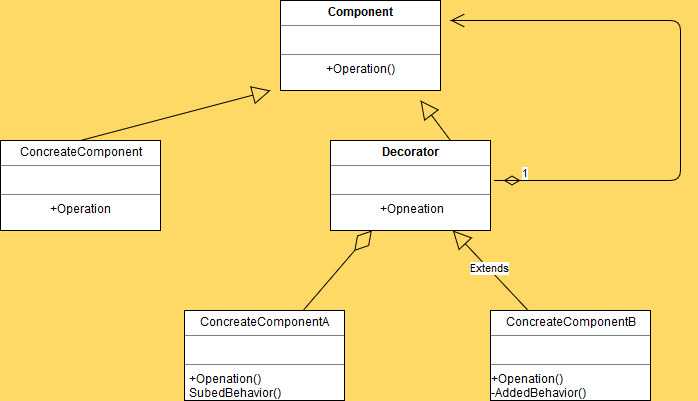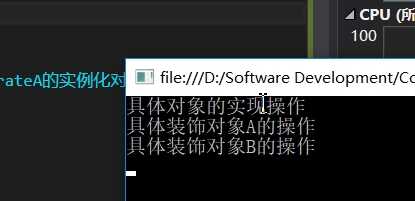一、概念:
动态的给一个对象添加一些额外的职责,就增加的功能来说,装饰模式比生成子类更为灵活。【DP】
二、通俗的理解;
装饰模式是利用其中的方法为来对对象进行包装的,这样每个包装对象的事项就和如何使用这个对象分离了,
每个对象只关心自己的功能,不需要关心如何添加到对象链中去。
三、附加类图;

四、对类图的解释;
Component是定义一个对象接口,可以给这些对象动态的添加职责,ConcreateComponent是定义了一个具体的对象,
也可以给这个对象添加 一些职责。Decorator,装饰抽象类,继承了Componet,从外类来扩展Component类的功能,
但对于Component来说,是无需知道Descorator的存在的。至于ConcreteDescorator就是具体的装饰对象,起到给Component添加职责的功能。
五、类图代码的附加;
using System;
using System.Collections.Generic;
using System.Linq;
using System.Text;
using System.Threading.Tasks;
namespace Decorator
{
//Component类;
public abstract class Component
{
public abstract void Operation(); //定义的接口中的实现方法
}
public class ConcreteComponent : Component
{
public override void Operation()
{
Console.WriteLine("具体对象的实现操作");
}
}
public class Decorator : Component
{
protected Component component;
public void SetComponent(Component component)
{
//设置Component
this.component = component;
}
public override void Operation()
//重写Operation(),实际是执行的是Component的Operation()
{
if (component != null)
{
component.Operation();
}
}
}
public class ConcreteDecoratorA : Decorator
{
public override void Operation()
{
base.Operation(); //关键的一步
SubedBehavior();
Console.WriteLine("具体装饰对象A的操作");
}
public void SubedBehavior()
{
//用来区别ConcreateDecoratorA和 ConcreateDecoratorB的区别
}
}
public class ConcreteDecoratorB : Decorator
{
public override void Operation()
{
base.Operation();
AddedBehavior();
Console.WriteLine("具体装饰对象B的操作");
}
public void AddedBehavior()
{
//用来区别ConcreateDecoratorA和 ConcreateDecoratorB的区别
}
}
//客户端代码的实现;
class Program
{
static void Main(string[] args)
{
ConcreteComponent c = new ConcreteComponent();
ConcreteDecoratorA d1 = new ConcreteDecoratorA();
ConcreteDecoratorB d2 = new ConcreteDecoratorB();
d1.SetComponent(c);
d2.SetComponent(d1);
d2.Operation();
//装饰的方法是:首先用ConcreteComponent实例话对象c,然后用ConcreteDecorateA的实例化对象d1来包装c,在用ConcreteDecoratorB的对象d2来包装d1,最终执行d2的Operation()
Console.ReadKey();
}
}
}
结果;

六、案例的使用;
在生活中我们时刻个电脑打交道,那么电脑就是我们补课或缺的一部分,那么我们肯定会给电脑进行添加东西,进行装饰了,有外观上的装饰,同样也有内在的性能改变,这就用到了装饰模式了。
对于电脑我们可以以性能的装饰来进行实例的演习。性能中,我们可以加固态硬盘、内存条等。那么进行演示:
代码的附加:
using System;
using System.Collections.Generic;
using System.Linq;
using System.Text;
using System.Threading.Tasks;
namespace Test_01
{
public abstract class Computer
{
public abstract void Show();
}
public class HPComputer:Computer
{
public override void Show()
{
Console.WriteLine("以下是对惠普电脑的一系列操作");
}
}
public class Decorator:Computer
{
protected Computer computer;
public void SetCompueter(Computer computer)
{
this.computer = computer;
}
public override void Show()
{
if(computer!=null)
{
computer.Show();
}
}
}
public class SSD:Decorator
{
public override void Show()
{
base.Show();
Console.WriteLine("我的电脑加装了固态硬盘");
}
}
public class Memory : Decorator
{
public override void Show()
{
base.Show();
Console.WriteLine("我的电脑加装了内存条");
}
}
class Program
{
static void Main(string[] args)
{
HPComputer decorator = new HPComputer();
SSD ssd = new SSD();
Memory memory = new Memory();
ssd.SetCompueter(decorator);
memory.SetCompueter(ssd);
memory.Show();
Console.ReadKey();
}
}
}
运行结果;

结语:到底在什么地方使用装饰模式;
当系统需要新功能的时候,是向旧的类中添加新的代码,这些新加的代码通常装饰了原有类的核心职责或主要行为。装饰模式是提供了一个非常好的解决方案,他把每个要装饰的功能放在单独的类中,并让这个类包装他所要装饰的对象,因此当需要执行特殊操作行为时,客户代码就可以在运行时根据需要有选择的,按顺序的使用装饰功能 包装对象了【DP】
优点
1、装饰者模式比继承更灵活
2、可以通过一种动态的方式来扩展一个对象的功能,在运行时选择不同的装饰器,从而实现不同的行为。
3、通过使用不同的具体装饰类以及这些装饰类的排列组合,可以创造出很多不同行为的组合。
缺点
1、会产生很多小对象,增加了系统的复杂性。
2、更加易于出错,排错也很困难,较为烦琐。
所以,使用装饰模式一定要小心小心再小心,万不可出错,不然BUG不断了。
